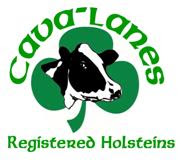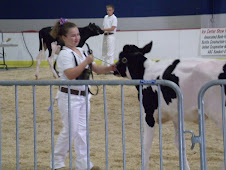Classification happens for us every 7 months. Before we classify we clip, wash and primp our cows. On classification day, we get up very early (or stay all night) to do finishing touches. Even though the cows were washed, tails are done separately. As you can imagine, the cows continue to produce manure which has to be cleaned before the classifier gets there.
Due to my new schedule, I was not able to get pictures of the cows getting clipped. I do, however, want to thank Anthony Fischer (Fischer Heights Dairy), Jim Neuser, Eric Haupt and Luke Lindsmeyer. These guys came in and clipped all the cows for us.
 I did make it to the barn for the first part of washing. Each cow is rinsed with warm water, then we add a whitening soap, and a final rinse.
I did make it to the barn for the first part of washing. Each cow is rinsed with warm water, then we add a whitening soap, and a final rinse.Yes, that is a pressure washer, that our good friend Jason Miller of Millercrest is using. We are very careful about how much pressure is used as well as how long the spray is allowed on each cow.
A HUGE Thank You to Jason for all his time and effort.
Again, I was so busy during all this that I didn't get any pictures of us doing tails. For their tails we get a bucket with warm soapy water and hold it up to them while soaking the tail. Then we wash away all the manure, rinse and comb them out. Imagine how many times we have to change the water in the pails!
Finally, the classifier arrives! This is important to us and our herd because it gives us an idea of how our cows are doing against other registered holsteins that are the same age. Our goal is to improve our herds BAA each time we score. This is not an easy goal to acheive. A "BAA" is Breeding Age Average. Each cow is looked at individually and scored based on her age, height, leg confirmation, udder capacity, udder placement, teat placement, and so on. There are 17 traits for the classifier to look at; broken into 5 scorecard breakdowns. If you look closely, she is holding a hand-held computer for her to enter the "breakdowns" into. The paper she is holding below the computer is the individual cow's registration paper. The registration paper will be stamped with the new score and date that the cow was scored.
idea of how our cows are doing against other registered holsteins that are the same age. Our goal is to improve our herds BAA each time we score. This is not an easy goal to acheive. A "BAA" is Breeding Age Average. Each cow is looked at individually and scored based on her age, height, leg confirmation, udder capacity, udder placement, teat placement, and so on. There are 17 traits for the classifier to look at; broken into 5 scorecard breakdowns. If you look closely, she is holding a hand-held computer for her to enter the "breakdowns" into. The paper she is holding below the computer is the individual cow's registration paper. The registration paper will be stamped with the new score and date that the cow was scored. As she scores each cow, she explains to us what she views as the cows strength and weakeness. The score is based on a 0 to 100 scale. In our herd we have 2 cows at 92; 2 at 91; and 3 at 90. I stopped there as these are our excellent scored cows. The breakdowns for these scores are just as important as the overall score.
As she scores each cow, she explains to us what she views as the cows strength and weakeness. The score is based on a 0 to 100 scale. In our herd we have 2 cows at 92; 2 at 91; and 3 at 90. I stopped there as these are our excellent scored cows. The breakdowns for these scores are just as important as the overall score.Having a herd of young cows will make your herds BAA a bit lower than someone with an older herd of cows. Young cows will typically start out with a lower score as they don't have the maturity that the older cows have.
There are many facets to being classified. There are some exceptions to this, but, each cow starts classification with their first lactation. Usually they are between the age of 2 and 3 years old. The score they receive each time they are scored can go up OR down, based on how the individual cow has matured. At the time the cow becomes 5 years old, her score becomes permanent. This means her score can no longer go down, she can, however, earn more points IF she continues to improve with age.
Each classifier has their own views, but are screened regularly by the Holstein Association to ensure that they are all as uniform in their assesment of cows as possible. Each time we have classified (since Todd and I have taken over the farm), we have had a different classifier. Classifier's are sent by the Holstein Association and we do not get to choose the person we get. This ensures that each herd is viewed by quality individuals that have a wide range of experience, but that don't see the same cows every time. Again, this helps to acheive the Holstein Association's goal of uniformity.
All in all we had a good day (January 19th). We won't know for a while what our new BAA is, but we were very excited to be listed, for the second year in a row, in Holstein World's list of top 200 herds in the USA for our BAA.







4 comments:
Thank you for taking time to explain all that - I hadn't a clue you guys went through all that!! Very interesting...I wouldn't have thought you'd have to worry about having clean cows - just a clean and sanitary barn for milking but I guess that "judging" comes from the FDA or someone?? Glad to hear you did so good!
Interesting process, thanks for sharing it! That is a lot of work, to happen every 7 months. How many cows do you have to prepare?
Thanks for taking time to read my stuff ladies!
We actually choose to go through this process as we are not required by any entity to have the animals scored. It does help us with sale/re-sale value of our herd.
We prepare all the animals in the barn...this includes dry cows and lactating cows. This time, our dry cows are in a different facility, so we only had to ready about 45. In th summer when they are all home it is between 45 and 65.
I wish I was more articulate and could explain how hard it is to get cows scored in the excellent range.
Thank you again for reading!
Thanks for stopping by and commenting. This is really interesting! The cows I'm around out here are mostly beef cattle, but my grandfather had a dairy for many years. He'd retired by the time I was born, but my mother often talks about her dairy days growing up. It's incredibly demanding work - but I had no clue about the scoring system, etc.
I just read some bits to my husband and he's informing me again how ignorant about cows - lol! I'll have to keep reading and surprise him with my new knowledge.
Hope the new jobs are going well!!!
Post a Comment